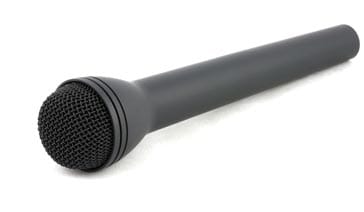Microphone Basics
Microphones are used wherever sound needs to be picked up and converted into an electrical format.
Microphone Tutorial Includes:
Microphone basics
Microphone types
Microphone specs
Microphone directionality
Dynamic microphone
Condenser microphone
Electret microphone
Ribbon microphone
Crystal / ceramic microphone
Boundary / PZM microphone
Carbon microphone
How to buy best microphone
Microphones for video
Microphones for vocals/ singing
Microphones are an essential part of any audio recording system. The microphone picks up the sound and converts it into electrical energy that can then be processed by electronic amplifiers and audio processing systems.

Microphones come in all shapes and sizes. Also different types of microphone may use different technologies. These different types of microphone have different properties, and therefore a knowledge of the various forms of microphone will enable the best microphone type to be chosen for a given application.
In terms of their technology, most microphones use electromagnetic induction (dynamic microphones), capacitance change (condenser microphones) or piezoelectricity (crystal or ceramic microphones) to produce an electrical signal from air pressure variations.
Microphones produce very small output signal levels. Accordingly they need to be connected to a preamplifier before the signal can be recorded or reproduced.
A knowledge of the different types of microphone also enables the way it is used to play to its strengths. So even if you are not a tecchie, it helps to know a little about them to use them to their best.
Microphone parameters
When choosing a microphone for any given application, it is necessary to take account of the various attributes, specifications and performance parameters that it has.
Some of the key parameters for microphones include:
- Fidelity
- Sensitivity
- Frequency response
- Directional attributes
- Robustness
- Cost
- Convenience of use
- Appearance
The importance of the different microphone parameters will depend upon the application. Before making a choice of any given microphone it is necessary to decide what is important.
Microphone features
When looking at the optimum microphone for any given application, there are many different parameters and issues to consider. Some of the issues will include the following features:
- Type of microphone: There are very many different types of microphone that are available. Each type has its own characteristics and is best suited for particular applications. . . . . . Read more about the different types of microphone.
- Directional characteristics: Microphones can have different sensitivity levels in different directions. The microphone directional characteristics are important in making sure the microphone used can pick up all the sounds that are needed. Accordingly the directional capabilities are of great importance and microphones are often characterised by them. . . . . . Read more about the microphone directionality.
- Diaphragm size: Microphones with different diaphragm sizes have different characteristics and are therefore often used in different applications.
Microphone history highlights
The development of the microphone has taken many years. Many improvements and developments have always been taking place, but some of the major highlights and milestones in the history of the microphone are summarised below.
| Microphone History Highlights | |
|---|---|
| Date | Development |
| 1665 | English physicist, Robert Hooke connected two cups together using a wire. This invention which is till used as a child’s game today enabled the sound vibrations to be carried between the two cups and heard over much greater distances than would normally be possible. |
| Mid 1800s | One early idea was invented by a German named Johann Philipp Reis. He designed a system that used a metallic strip attached to a vibrating membrane. This produced an intermittent current in line with the sound vibrations. |
| 1876 | Scottish-American Alexander Graham Bell as part of his telephone. In this a diaphragm was attached to a conductive rod in an acid solution, and although an improvement on previous inventions, it still gave very poor sound quality. |
| 1870s | Englishman David Edward Hughes invented a carbon microphone. It was based around the concept that when carbon granules are compressed by sound waves, they change their resistance. |
| 1877 | The idea for the carbon microphone was also developed separately by Emile Berliner and Thomas Edison in the USA. After a legal dispute, Edison was awarded the first patent in 1877, although Hughes had demonstrated his device before witnesses before Berliner and Edison had developed their idea. Accordingly Hughes is normally credited with the idea. |
| 1916 | C. Wente of Bell Labs invented the condenser microphone. |
| 1923 | Captain H J Round developed the first practical moving coil microphone. This was used by the BBC and was later improved upon by Alan Blumlein. |
| 1923 | Ribbon microphone was introduced. Probably developed by Harry Olson, it was able to provide a considerable improvement in performance over other years. |
 Written by Ian Poole .
Written by Ian Poole .
Experienced electronics engineer and author.
More Audio Video Topics:
HDMI
SCART
DisplayPort
DVI
Loudspeaker technology
Headphones & earphones
Bluetooth speakers
Stereo sound
Microphones
Audio compact cassettes
Vinyl record technology
Digital radio
DVB television
Return to Audio / Video menu . . .


